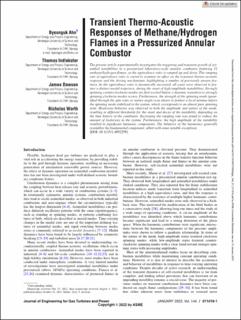Transient Thermo-Acoustic Responses of Methane/Hydrogen Flames in a Pressurized Annular Combustor
Peer reviewed, Journal article
Published version

Åpne
Permanent lenke
https://hdl.handle.net/11250/2988267Utgivelsesdato
2022Metadata
Vis full innførselSamlinger
Originalversjon
Journal of Engineering For Gas Turbines and Power. 2022, 144 (1), . https://doi.org/10.1115/1.4052259Sammendrag
The present article experimentally investigates the triggering and transient growth of azimuthal instabilities in a pressurized laboratory-scale annular combustor featuring 12 methane/hydrogen flames, as the equivalence ratio is ramped up and down. The ramping rate of equivalence ratio is varied to examine its effect on the transient thermo-acoustic response and the driving mechanisms, highlighting a number of previously unseen features. As the equivalence ratio is dynamically increased, all cases were observed to feature a distinct modal trajectory, during the onset of high-amplitude instabilities. Strongly spinning counterclockwise modes are first excited before a dynamic transition to strongly spinning clockwise modes occurs. Furthermore, the strength of the spinning mode (quantified through the spin ratio or nature angle) was shown to feature a local minima before the spinning mode stabilized in the system, which corresponds to an almost pure spinning state. Hysteresis behavior was observed in both the amplitude and nature of the mode, resulting in different thresholds for the onset and decay of the instability, depending on the time history of the combustor. Increasing the ramping rate was found to reduce the amount of hysteresis in the system. Furthermore, the high amplitude of the instability resulted in significant harmonic components. The behavior of the harmonics generally resembles the fundamental component, albeit with some notable exceptions.